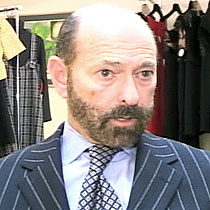2007年VOA标准英语-Fashion Brings $3 Billion Annually to New York(在线收听)
By Kane Farabaugh
New York City
08 February 2007
watch Business of Fashion
Twice a year, the international fashion spotlight shines on New York during Fashion Week. It is a chance for top clothing designers to introduce their new styles and seasonal colors. While it is the most recognizable part of a major industry in New York City, it's not necessarily representative of the thousands of apparel manufacturers in the city's Garment District. From New York, VOA's Kane Farabaugh reports on a designer and manufacturer who benefits from Fashion Week, but doesn't have models on the catwalk.
 |
| Alan Sealove |
Sealove’s father founded Victoria Royal over 50 years ago. He now runs the company together with his brother. While they have outfitted everyone from television game show hostess Vanna White to former first lady, and now Senator, Hillary Rodham Clinton, they are primarily a manufacturer of clothes sold in department stores and boutiques.
Though Victoria Royal enjoys success in New York's highly competitive garment industry, the company has done it without modeling clothing in the glitz and glamour of the celebrity-studded Fashion Week.
Sealove says the proposition is costly. "That's not the route we want. It's a very costly proposition to have a show. A runway show is really expensive. What we do is take our energy and our marketing energy and our advertising energy in a different direction. We target our stores. We go after the business of our stores."
Barbara Blair Randall is the Executive Director of the Fashion Center in New York City. She says that the front row at runway shows during Fashion Week is more a place for celebrities and Manhattan socialites than industry buyers. It's all about "being seen" rather than seeing new fashions.
"It's completely crass and base. If you ask me -- and you did (laughing) -- I'm sorry to say but it's really celebrity driven."
Though it might be celebrity driven, Sealove welcomes the extra attention that comes with Fashion Week, even if his company is not modeling clothing on the runways. "The fact that the shows get the publicity, that's just good stuff for all of us. Bring attention to the apparel industry, and bring the fashion press into New York is just very helpful for all of us."
Apparel manufacturing brings in more than $3 billion a year to New York City. The staff of Victoria Royal represents the working class in this line of work in an industry that currently employs more than 60,000 people.
'It's perhaps less glamorous than the fashion shows and the runway shows and the models and that party attitude about the introduction to product,” says Sealove, “and we instead of introducing our product to the press as the shows do, we introduce our product to the stores. Ultimately the people that show to the press will ultimately sell to the stores. We bypass that completely and just go directly to showing and building our business and client base in the retail establishment."
Alan Sealove isn't alone. He says he competes with about ten other companies in the style of clothing his company delivers to the market. Most take their designs directly to the retail buyers. "There are thousands of companies based in New York that are wholesalers / manufacturers that design, ship, market, produce their own designs and the whole backbone of the entire apparel industry are the smaller based companies. We're somewhat well-known in the industry because we have longevity. We've been around an awful long time. We never take a day for granted."
And neither does Mary Bays, a designer for Victoria Royal. Her name might not be as famous as Oscar De La Renta or Donna Karen, but Mary Bays is a designer on the rise.
Her label -- the Mary Bays Collection -- graces thousands of pieces of clothing for sale in department stores and boutiques around the United States. Bays appreciates the importance of Fashion Week for the industry because it influences the women who buy her clothing. "It's important to fashion in general. It's important to the city. It's important to the country. It's important to someone who lives in a small town who wants to look fashionable to know what's going on and to see these shows, so when she walks into a specialty boutique, that she knows what to buy, and she knows what's happening. It may not be the designer thing she sees on the runway, but it will have a look. What happens this week sets a trend."
Those trends eventually fan out across the globe, and according to Barbara Blair Randall, not only change the way we look, but also the way we feel.
“A lot of times, people view Fashion as frivolous and not important. And you know something, if you look at it in terms of the issues that humanity is faced with on this globe, certainly how we package ourselves is not a top priority. But I will tell you, for the individual and the psychological impact of who we are and how we carry ourselves and how we express ourselves is certainly influenced by how we package ourselves and how we feel about that packaging.”
That packaging, whether it is on display in Alan Sealove's office or on the runway during Fashion Week, is ultimately what's on sale to the world's consumers. Year to year, the changing fashions fuel the ever-changing garment industry in New York City… from the top designers, to the everyday apparel manufacturers like Victoria Royale.